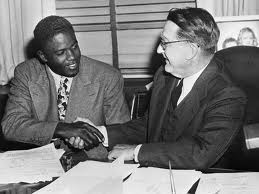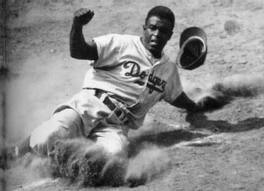Aesthetic
Realism seminar:
"Care for Yourself & Justice to Others;
Do They
Have to Fight?" Part 3
with a
discussion about Branch Rickey
By Michael
Palmer
Meanwhile, Robinson did agree to the deal and he
joined the Dodgers top farm team in Montreal for the 1946 season.
4. THERE WAS FURY
The reaction to this,
and to Robinson’s historic joining the Dodgers the following year was rage
in various people. In a closed meeting earlier, all but one of the 16 major
league club-owners had voted against integrating the game. Some players
on the Dodgers even signed a petition against Robinson playing. He was
the target of insults from opposing players and fans and even got death
threats. The way Robinson retaliated was with magnificent play on the field,
leading the Dodgers to a pennant in that first year and he was voted the
rookie of the year.  I
witnessed this and it was thrilling! And at this time Rickey, I feel, took
care of the best thing in himself, going all out to back him. He
traded the Dodger players who had opposed Robinson, including their most
popular man, Dixie Walker. Two years later, Robinson was voted the league’s
most valuable player, leading the Dodgers to still another pennant with
Rickey behind him every step of the way. Largely, for his fight for
justice in ending this racial segregation, Rickey was voted into Baseball’s
Hall of Fame. I
witnessed this and it was thrilling! And at this time Rickey, I feel, took
care of the best thing in himself, going all out to back him. He
traded the Dodger players who had opposed Robinson, including their most
popular man, Dixie Walker. Two years later, Robinson was voted the league’s
most valuable player, leading the Dodgers to still another pennant with
Rickey behind him every step of the way. Largely, for his fight for
justice in ending this racial segregation, Rickey was voted into Baseball’s
Hall of Fame.
V. PERSONAL OBSERVATION OF INJUSTICE
When I made my first visit
to the Hall of Fame in 2010 I was surprised and deeply moved to come
upon a room devoted entirely to the Negro Leagues. There were team photos
of the Homestead Grays, Pittsburgh Crawfords, and Jackie Robinson’s team,
the Kansas City Monarchs. And accompanying the pictures were explanations
of what these players had to go through in the Jim Crow years of injustice,
indignity, and even fear for their lives. It made for greater respect for
them and I found myself usefully ashamed of the awful, mild way I’d met
the reality of their lives years earlier, outside Yankee Stadium.
Branch Rickey died in 1965 at the age of 84.
Three years earlier, though in poor health, he was able to be in Cooperstown
for Jackie Robinson’s induction in the Hall of Fame. In his acceptance,
Robinson thanked three people who had meant the most to him: his mother,
his wife Rachel and “a man,” he said, “who has been like a father to me,
Branch Rickey.” Rickey, it was said, beamed with pride.
Though he never took the credit for breaking baseball’s
color barrier, Rickey did say, “I cannot face my God much longer knowing
that his black men are held separate from his white men in the game that
has given me all that I call my own.” Hearing this, I thought of Eli Siegel’s
words describing the inevitability of justice: “Ethics is a force like
electricity, steam, the atom—and will have its way. “Ethics, he said, “is
the art of enjoying justice.”
Yes, Aesthetic Realism shows beautifully and conclusively
that justice to others and care for oneself do not have to fight. They
can be gloriously one.
click here to return to Part 1
|